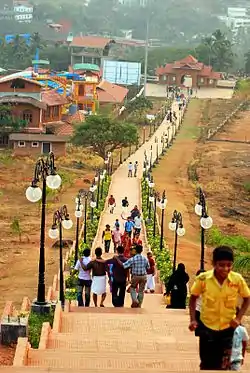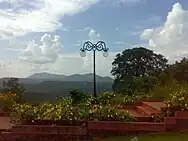Kottakkunnu
Kottakkunnu is a hill station in Malappuram district of Kerala state India. Widely known as Kotta Kunnu, it is situated at a height of 915 metres and is a popular tourist destination in the state of Kerala located at Malappuram.[1]
Kottakkunnu
Kottakkunnu Hill Station | |
|---|---|
Hill station | |
 Kottakunnu | |
 Kottakkunnu location in Kerala,India  Kottakkunnu Kottakkunnu (India)  Kottakkunnu Kottakkunnu (Asia) .svg.png.webp) Kottakkunnu Kottakkunnu (Earth) | |
| Coordinates: 11.048°N 76.083°E | |
| Country | |
| State | Kerala |
| District | Malappuram |
| Languages | |
| Time zone | UTC+5:30 (IST) |
History
The name Kottakunnu comes from the fort built here when the area was the military headquarters of the Calicut rulers Zamorins . Due to the geographical importance of this area, the fort known as Malappuram Fort was built here and the city of Malappuram came up.
These areas became part of Valluvanad after the Perumal rule of the Chera kingdom that ruled Kerala in ancient times.
At the end of a mountain, the place is a strategic area that is three parts river, one part deep gorge and the upper part is flat like a pedestal. The modern city is spread over the slope of this hill and the plains below.
By the twelfth century, the Eradis of Nediyiruppu Swarupam near Kondotty established a kingdom in South Malabar with their headquarters at Calicut. They were the founders of the Zamorins dynasty. Each of the other kingdoms became a part of Calicut through military operations by land and sea with support of Kshatriya Nair (a martial caste in Hinduism) and Moplah muslim soldiers. Malappuram and the surrounding area were subjugated from Valluvakonathiri under the leadership of Varakkal Paranambisan. Thacharakavil Eradis, who were the relatives of Nediyiruppu Swarupam defeated Muthan tribes who were the rulers of the Nilambur forest and the region became part of the Zamorins' kingdom. The Muthans, who lost their kingdom through fraud, risked their pride and took refuge in the mountains so as not to live as slaves. Their generation, called Malamuthans (Mala in malayalam mountain), who are still aloof from other peoples, are scattered in the mountains that are part of the Western Ghats in today's panchayats like Urangattiri, Edavanna, Mampad and Chaliyar. The Eradis of Thacharakavil were the founder of Nilambur Kovilakam. Under head and controller of Calicut port Shah Bandar Koya, with the help of Thirumalasseri Namboothiri and Kalpakanchery Tambrans, attacked Thirunavaya and got the authority from Valluvakonathiri to hold the position of Raksha Purusha (Great protector) in Mamangam ( a 28-day-long trade festival celebrated once every 12 years in Kerala on the banks of the Bharathappuzha). After this incident Valluvakonathiri started to send Chaveras (victory or death army) to kill Zamorin during the Mamangam festival to regain the patronage.
Varakkal Paranabisan, who conquered Malappuram and the surrounding area from Valluvakonathiri, built a fort on top of Kottakunnu. The gates of the fort are the places known today as the commercial center Kottapadi (Fortgate) at Downhill and Moonampadi ( Third gate) on the Nilambur road. Paranambi ruled Ernad with Kottapadi as the headquarters and continued military operations against Valluvanadu and other kingdoms with Kottakkunnu fort as the military center. After the Zamorins conquered the part of the Kadalundi river where the Cherupuzha joins, it became necessary to pay taxes in Malappuram to bring the goods from the Valluvanadu to the Sea port or forced to sell to the traders of Calicut which resulted formation of small trade center in the area called Kootilangadi. During the staring of 18th centrury the Paranambi of the time was defeated in a battle with Puntrakonathiri, the ruler of Kottakkal, and was captured by the enemy soldiers. The Moplah Muslim traders fought them and released Paranambi. Pleased with this, Paranambi built the famous Jama mosque near the Kadalundi river and a commercial center developed around the mosque known as Valiyangadi. With this, in the early 1700s, Malappuram became a commercial center beyond being a military center.
Apart from Valluvanad, the military operations of Zamorins were threatened, Palakkad's ruler , Palakkattu Achan, who asked for help from Mysore Wodeyar King's Dindigul governor Hyder Ali, Hyder Ali's army conquered Malabar and realizing the failure, the then Zamorin set fire to his ammunition and committed suicide. With this, the mamangam that the Zamorins held the patronage came to an end.
In the meantime, the administration of Mysore came into the hands of Hyder Ali and after Hyder Ali his son Tippu Sultan became the rulers of Malabar under Mysore. During Tippu's time Malappuram fort was developed and cannons, ammunition etc. were brought from Mysore and made into a strong military centre. Many roads were constructed to link Malappuram fort. Malappuram-Thamarassery road, Malappuram-Palakkad road, Malappuram-Feroke road, Malappuram-Parappanangadi road, Malappuram-Kolathur-Pattambi road were the roads built at that time. Tippu Sultan decided to build a fort centered on Feroke as the headquarters of Malabar. The roads were connected with Palakkad Fort, Feroke Fort, Ramagiri Fort near Pattambi, Palur Fort, Thamarassery Pass, Karakur (Nadugani) Pass and Walayar Pass etc..
The agrarian reforms of Tippu Sultan and a Brahmin named Madanna, who was the Receiver Governor of Malabar during the reign of the Mysore Sultans, favored the tenant farmers and cost the landlords. Reforms in taxation according to the level of agricultural production, giving privilege to agricultural land to first-time farmers on barren land, and taxing landlords on their agricultural products caused many landlords to oppose Tippu. Landlords like Pazassi king and Manjeri Athan Kurikkal (Hassan Gurukkal) turned against Tippu along with the British East India company. The Manjeri Athan Kurikkal was the tax collector and ammunition keepers in Manjeri during the reign of Zamorins. Manjeri Kovilakam which was related to Valluvakonathiri, was Tippu's administrative representative in Manjeri . The Athan Kurikkal demolished Manjeri Kovilakam and Tippu came to know about this and captured the Athan Kurikkal in a military operation and imprisoned in Mysore.
In 1792 Tippu sultan defeted by British in the Third Anglo-Mysore War, ceded Malabar to the British alliance under the Treaty of Srirangapattana and released all the prisoners, including the Athan Kurikkal of Malabar. The Malappuram fort came under the control of the Athan Kurikkal. Malabar was annexed by the British to the Bombay Presidency and made a direct colony of Britain and only certain people were empowered to collect taxes. This led to the opposition of Pazhassi King , Athan Kurikkal and others who helped the British against Tippu. British came to know that Pazhassi king was try to start alliance with Tippu, they gave many temptations to Pazhassi and the Athan Kurikkal . But they rejected the temptations and launched many protests against the British. When Tippu was killed at Srirangapatna in 1799, the British retaliated strongly against them.
In 1806, Manjeri Athan Kurikkal was killed in the battle of Mappattukara near Pattambi and thus Malappuram Fort came under the British.
The beautiful view from the top of the Malappuram hill and the gentle breeze made the area a British military base. Some British documents refer to Malappuram hill as one of the most beautiful military bases in India. Malappuram was also known as the last military center of the British Empire in the southern part of India at that time. Malappuram fort was demolished and a gunnery training center was built there. In the 1800s, the anti-British rebellions in South Malabar, known as the Moplah Rebellions, led to the establishment of several military bases in and around Malappuram. A paramilitary unit called Malappuram Special Police was established in Malappuram in 1885. During the Malabar uprising against British empire in 1921, it was raised as the Malabar Special Police. During the Malabar War of 1921, several British military units such as the Leinster Regiment and the Dorset Regiment were encamped in Malappuram.The Leinster Regiment, a military unit of Southern Ireland was the last military alliance with the British soldiers at Malappuram in 1921. After that, Southern Ireland became an independent republic from Britain.
During British rule, a military court was established at Kottakunnu and many freedom fighters were tried and executed.
Variyankunnath Kunjahmad Haji, British rebel ruler during Malabar uprising, and his two assistants were tried and shot dead by the British court on the afternoon of January 20, 1922, on the northern slopes of Kottakunnu. It was there that his body and the documents of the British rebel state he established as the Malayalam Rajyam were burnt. Now Malappuram Municipality has built a town hall in his memory below Kottakunnu.
After British rule in 1947, many British military bases including Kotakunnu in Malappuram came under the Department of Defence under Central Ministry of India . The main military headquarters is the present District Collectorate of Malappuram . Apart from the Malabar Special Police, a paramilitary force under the Kerala Police, other military centers were abolished. In 1956, when Malabar, which was a part of Madras State, was annexed to Kerala State, a section of Malabar Special Police was transferred to Tamil Nadu under the name of Madras Special Police.
Malappuram is a region with the highest number of football fans in India. But there were few spacious places to play football. Big games have to wait until the paddy fields are harvested. As a result of Malappuram Municipality's constant efforts to build an international football stadium, Central Government of India handed over Kottakunnu to the Malappuram Municipality in 1996. But as studies have shown that Kottakunnu is an ecologically fragile area, so the construction of stadium will cause ecological problems. Then the stadium was constructed at Payyanad near Manjeri and instead of the stadium a beautiful garden was built in Kottakunnu. Today many entertainment centers like art gallery, amusement park, children's park etc... have been built there.
On May 17, 1998 the Kudumbasree mission, a women's empowerment scheme of the Government of Kerala, was inaugurated by the Prime Minister Atal Bihari Vajpayee at Kottakunnu.
On August 09, 2019, three people, including a child, died in a landslide in Kottakunnu due to heavy rain.
.jpg.webp)
